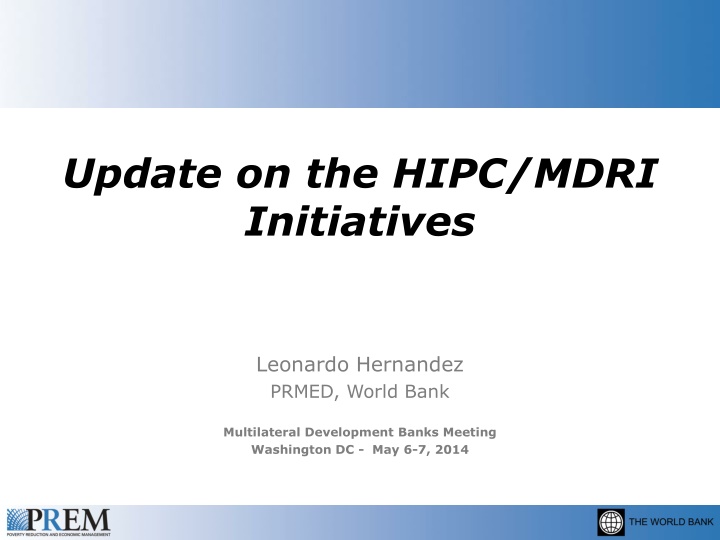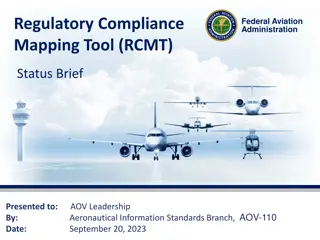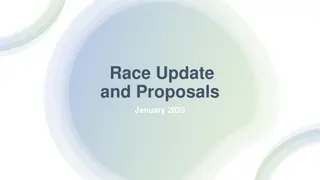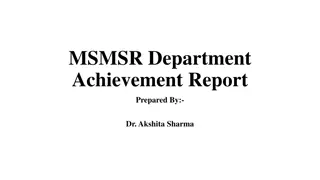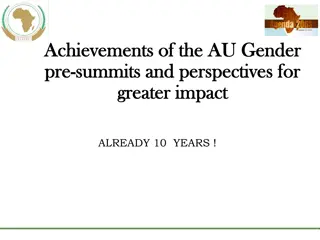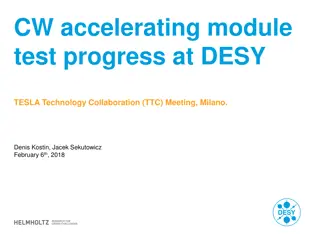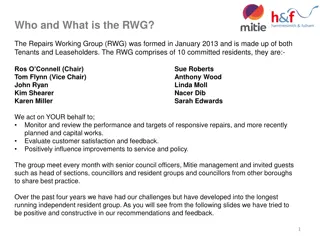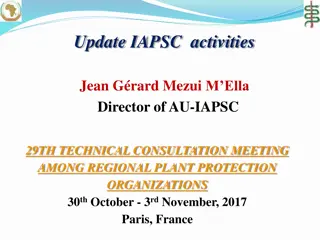Update on HIPC/MDRI Initiatives: Achievements and Challenges
Significant progress has been made in debt relief initiatives such as HIPC and MDRI, with over $116 billion committed to eligible countries. The HIPC/MDRI Initiative is nearly fully implemented, benefiting countries by reducing external commercial debt and lowering the risk of debt distress. Challenges remain in addressing the remaining debt stock and ensuring full participation from creditors.
Download Presentation

Please find below an Image/Link to download the presentation.
The content on the website is provided AS IS for your information and personal use only. It may not be sold, licensed, or shared on other websites without obtaining consent from the author.If you encounter any issues during the download, it is possible that the publisher has removed the file from their server.
You are allowed to download the files provided on this website for personal or commercial use, subject to the condition that they are used lawfully. All files are the property of their respective owners.
The content on the website is provided AS IS for your information and personal use only. It may not be sold, licensed, or shared on other websites without obtaining consent from the author.
E N D
Presentation Transcript
Update on the HIPC/MDRI Initiatives Leonardo Hernandez PRMED, World Bank Multilateral Development Banks Meeting Washington DC - May 6-7, 2014
Outline 1.What has been achieved 2.What are the current challenges 1
1. What has been achieved Substantial debt relief has been committed HIPC Initiative and MDRI: Estimates of Debt Relief (End-2013 PV terms, in billions of U.S. dollars) to 39 HIPC eligible countries: WORLD BANK GROUP DEBT RELIEF TOTAL DEBT RELIEF HIPC MDRI HIPC and MDRI HIPC MDRI HIPC and MDRI Estimated US$116 billion have been committed under the HIPC (US$75 billion) and the MDRI (US$41 billion) Initiatives. 14.5 27.5 42.0 75.0 41.3 116.3 All HIPCs 35 Post-Completion- Point HIPCs 13.0 26.4 39.4 57.8 39.3 97.1 0.1 0.5 0.5 0.2 0.7 0.9 1 Interim HIPCs 3 Pre-Decision-Point HIPCs 1.5 0.6 2.1 17.0 1.3 18.3 Paris Club (36.4%) with Multilaterals IDA (19.4%), other MDBs (16.5%) and the IMF (8.5%) account for 4/5 of the HIPC debt relief costs. 3
1. What has been achieved The HIPC/MDRI Initiative is Almost Fully Implemented Considerable progress has been achieved under HIPC Initiative %GDP 35 out of 39 HIPC eligible countries have completed the Initiative Chad aims to reach HIPC Initiative s completion point by end 2014 Only three eligible HIPCs that wish to avail to the Initiative (Eritrea, Somalia and Sudan) have not reached the decision point Zimbabwe s eligibility is being assessed 4
1. What has been achieved Dealing with External Commercial Debt in LICs The World Bank s Debt Reduction Facility (DRF) has supported US$10 billion in buybacks in 21 HIPC countries 14.0 100 95 98 85 85 90 On average, buyback prices on DRF-supported operations have declined, while creditor participation rates have remained high. 12.0 Participation rates (%) 80 Repurchase price (cents to US$) 10.0 70 8.0 60 12.8 50 6.0 Since 2004 formal link of DRF to HIPC, participation rates have increased, although further effort is needed to resolve the remaining stock of external commercial debt. 40 8.2 4.0 30 4.1 2.0 3.9 20 0.0 10 1991-1995 1996-1999 2000-2004 2005 -2010 Weighted averages 5
1. What has been achieved Risk of Debt Distress Has Fallen for HIPCs Changes in countries risks of debt distress: 2006-13 (post-DP HIPCs) Countries in debt distress or at high risk of distress fell from 18 to 8. Countries at low risk almost tripled from 5 to 13. Debt relief has opened space for countries to contract new debt, including non-concessional, and markets want to lend to LICs again. Going forward, macro-fiscal policies and investment and growth strategies will matter the most for debt sustainability. 40 35 8 9 11 11 30 Number of countries 14 17 17 18 25 15 20 14 12 12 12 15 9 12 13 10 13 13 13 13 5 10 10 7 5 0 2006 2007 2008 2009 2010 2011 2012 2013 6
1. What has been achieved Poverty-reducing Expenditures are up, debt service is down Poverty-Reducing Expenditure and Debt Service in 36 Post-Decision-Point HIPCs (simple average; % of GDP) Poverty-reducing expenditures by HIPC countries increased by more than three percentage points of GDP, on average, while debt service payments have declined. Causality and additionally are harder to assess. 7
1. What has been achieved CPIA overall ratings and the debt policy ratings have improved in post-CP HIPCs between 2006 and 2012 Post-CP HIPCs policies and institutions are stronger than in pre-decision point and interim HIPCs In almost 80 % of HIPCs the overall CPIA rating has improved 37% of post-CP HIPCs improved their debt policy (14 countries), against 11% which saw a deterioration (4 countries) However, still countries have a long way to demonstrate the best practice max rating 6
2.What are the current challenges
2. What Are Current Challenges Assisting remaining HIPCs to benefit from the Initiatives: HIPC/MDRI and DRF Chad reached HIPC DP in 2001. Expected CP: December, 2014. Remaining milestone: successful implementation of the IMF Program leading to the Initiative s completion A new IMF Extended Credit Facility (ECF) Program (April Sept. 2014) was discussed with the Fund in April, 2014. Under the assumption that the ECF is well implemented during this period, the HIPC CP could be reached by December, 2014. Eritrea, Somalia and Sudan have been unable to reach the HIPC decision point since 2006. Zimbabwe faces severe debt situation, with eligibility under HIPC still uncertain The World Bank and the IMF are undertaking a loan by loan data reconciliation and analysis. A joint debt reconciliation mission will visit Harare in May with the final assessment ready by end June. Potential DRF clients (24), both big and small, representing an estimated US$11.2b in external commercial debt, could be eligible for relief, more than doubling the volume already provided (21 countries).
2. What Are Current Challenges Uncertain external environment Global growth has picked up from the weakness of mid 2012, but downside risks remain big question mark is the reaction to the tapering of the QE. Commodity prices boom is over. Global financial conditions remain mild for developing countries, but those with large imbalances credit booms and high exposure to capital inflows will face a harder adjustment path. Developing country fundamentals, policies and reforms, will play an important role on whether they will have an orderly or disorderly adjustment. Political stability has deteriorated recently in some post- completion point HIPCs e.g. CAR, DRC, Mali, but it is paramount for economic growth and sustainable debt management.
2.What Are Current Challenges In this context it is critical to decide How muchto finance: Take into account initial conditions (debt situation), the global environment (volatility) and the country s repayment capacity in the short and medium term (DSA). What to finance: Choose feasible projects with the highest social return (Public Investment Management). How to finance (choice of instruments): MTDS cost/risk trade offs among alternatives; look into macro implications of alternative debt instruments.
2.What Are Current Challenges Post-CP have benefitted from global low-interest environment by issuing Eurobonds, although conditions are tightening Eurobond issuance by post-HIPCs (USD millions) Eurobond redemption for post-HIPCs (USD millions) 2000 1,800 1800 2014 1,600 1600 2013 1,400 1400 Mozambique 2012 8.75- 8.875% Rwanda 1200 1,200 2011 Honduras 1000 2009 1,000 Tanzania 2007 800 800 8.75% (Dec) 5.95% Senegal 600 Zambia 600 8.75% 400 Bolivia 7.5% (Mar) 5.375% 400 4.785% Ghana 200 200 8.75% 0 0 2017 2020 2021 2022 2023 2024 Note: Senegal bought back its USD 200 million bond maturing in 2014
2.What Are Current Challenges Several low-income countries with high and rising government debt might be building up vulnerabilities % of GDP Gross general government debt 80 Debt in 2012 Change in debt since 2007 (percentage points) 60 40 20 0 Source: Global Economic Prospects June 2013 and IMF
2.What Are Current Challenges Some LIC s are accumulating high levels of domestic debt that tends to have high interest rates and short maturities Domestic debt to GDP 15
2. What Are Current Challenges How Countries Borrow Matters Increasingly: New Financing Instruments Bring New Fiscal Risks & Rollover Risks LICs tend to have short average maturity for domestic debt: Ghana: Redemption Profile (2012, USD 000) 8,000 T-bills Senegal Ghana Tanzania Mozambique 2.6 years 2.4 years 1.6 years 5.1 years 7,000 External Domestic 6,000 5,000 Sovereign Bond 4,000 Effective interest payments can be high on ST domestic debt: Senegal 5.6 % Ghana 18.5 % Tanzania 8.9 % Mozambique 15.4 % 3,000 Multilateral Concessional 2,000 1,000 0 2013 2019 2021 2023 2025 2027 2029 2031 2033 2035 2037 2039 2041 2043 2049 2015 2017 2045 2047 Risky combination with sovereign bond spikes 16
2.What Are Current Challenges What did countries do with increased borrowing space? Ghana borrowing contract non-concessional debt and domestic debt and increased consumption. used space new to public The Gambia maintained low external debt, but increased domestic debt while increasing investment Are returns to investment enough? public high 17
2. What Are Current Challenges Debt management capacity needs to be further strengthened The results from 65 DEMPAs indicate deficiencies in the following DEM areas: Legal framework 65 Debt Reporting Managerial Structure 60 55 50 Debt Management Strategy Debt Records 45 the quality of debt management strategies 40 35 30 Segregation of Duties, Staff Capacity and BCP Evaluation of Debt Management Operations 25 20 15 10 5 performance audits of debt-management policies and functions 0 Debt Administration and Data Security Audit Cash Flow Forecasting and Cash Balance Management Coordination with Fiscal Policy weak policies and procedures for external borrowings Loan Guarantees, On lending Derivatives Coordination with Monetary Policy External Borrowing Domestic Borrowing operational risk management and cash balance management. Meet with the requirements of Score C or Higher Scores Not meet with minimum requirements 18
Thank You! For more information: http://www.worldbank.org/debt 19
